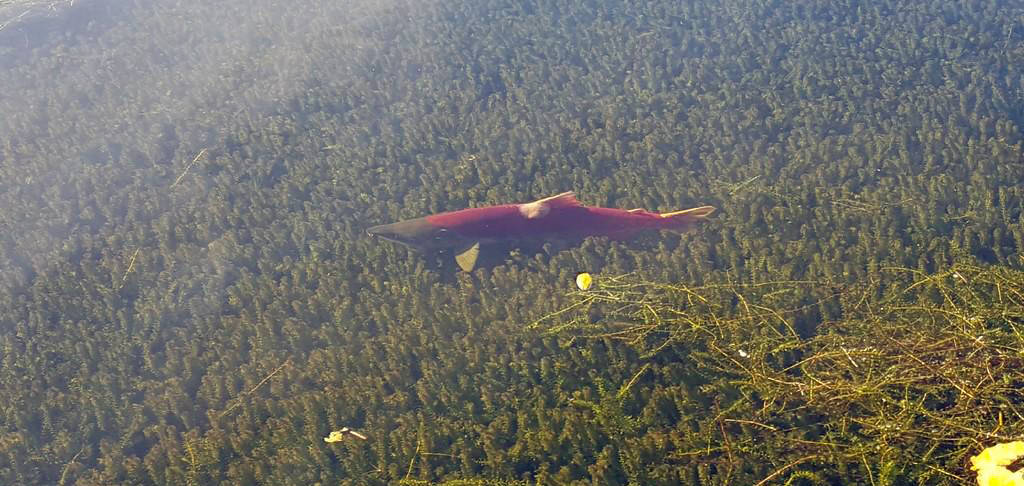By JOHN MORTON
In August, at the 2018 Industry Appreciation Day in Kenai, the elodea partnership on the Kenai Peninsula was acknowledged for Outstanding Fish Habitat Conservation. The United Cook Inlet Drift Association nominated the partnership and I was the face that accepted this very nice award.
The elodea partnership, a subcommittee of the Kenai Peninsula Cooperative Weed Management Area, has been unusually motivated and successful in eradicating elodea from the Kenai Peninsula. Elodea is the first aquatic invasive plant to establish in Alaska and it has already shown itself to be quick at spreading and able to cause great harm.
Dr. Toby Schwoerer, with the University of Alaska Anchorage Institute of Social and Economic Research, estimates elodea will likely cost $100 million annual loss in revenue to commercial sockeye fisheries and charter floatplane operators if it disperses throughout Alaska.
In some lakes, like Chena Lake in Fairbanks, it is thick enough to hinder canoe paddling. Walt Nesbett, a Sucker Lake landowner in the Matanuska-Susitna valleys, believes beaver abandoned his lake because they could no longer drag branches through elodea-infested waters.
Here on the Kenai Peninsula, the partnership pioneered the use of aquatic herbicides and was the first to successfully eradicate elodea from an Alaska waterbody. Of five known infestations on the Kenai, four were successfully eradicated (Beck, Daniels, Stormy, Sports Lakes) and the fifth is likely to be gone by next summer.
What is so unusual about the elodea partnership is that local, state and federal agencies and NGOs came together to work voluntarily on a problem with no funding available, and then not only made it work, but in a short time frame.
Mike Navarre, our former borough mayor, remarks, “This collective effort is a great example of how to responsibly deal with public policy issues. A problem was identified and everyone came together with the goal of addressing the problem and educating the public on the issue. The focus was on resolving the problem rather than placing blame or claiming credit.”
As with most partnerships, it wasn’t the organizations and agencies involved that made the difference — it was individuals. Early on, shortly after elodea was found in Stormy Lake in 2012, Brianne Blackburn and later Heather Lescanec (Alaska Department of Natural Resources), Matt Steffy (Homer Soil & Water Conservation District) and myself (Kenai National Wildlife Refuge) organized the first public meetings in Nikiski, as well as the partnership itself.
We were also the heavy hitters in the permitting process and in raising funds, and later during the actual herbicide treatments when others such as Matt Bowser and Todd Eskelin from the Kenai refuge also weighed in.
Mike Navarre, as former mayor, provided $40,000 to initially seed the effort. With help from Michele Aranquiz, former assistant to the mayor, the borough assembly later approved a $400,000 request for state capital funding that provided critical momentum for eradication efforts eventually costing more than twice that amount.
As this battle with elodea has played out, everyone has had roles to play. Jack Blackwell (Alaska State Parks) agreed to close Stormy Lake‘s public boat launch to reduce the risk of more spread.
Later, Tammy Davis and Jeff Breakfield (Alaska Department of Fish & Game) helped close Sport Lake’s public boat launch, even while providing staff to inspect for elodea on boats and trailers when it was open.
Cheryl Anderson (Kenai Fish & Wildlife Field Office) and Dr. Libby Bella (Kenai refuge) surveyed many lakes in 2013. Edgar Guerron-Orejuela and Jen Hester, with the Kenai Watershed Forum, continued those surveys, and rounded up funds to evaluate the use of eDNA to detect elodea and the degradation of residual herbicide in lake sediments.
Lisa Ka’aihue and others at the Cook Inlet Aquaculture Association were quick to install nets to prevent elodea from washing downstream, and more recently to survey Mat-Su lakes. Janice Chumley (UAF Cooperative Extension Service) was always quick to help with public outreach.
Several Daniels Lake landowners, Bill Haese, Bill and Michele Hartline, and Stacy Oliva, enthusiastically contributed their personal time to this planning effort. Craig Ralston and Susan Stockdale graciously provided boat access to Beck Lake.
Outside experts provided free consultation. Dr. Lars Anderson (University of California-Davis) helped launch us down the right planning path. Scott Shuler and Dr. Andrew Skibo (SePRO Corporation) provided support during the early days when we really didn’t understand technical aspects of the herbicides or application equipment. Dr. Don Les (University of Connecticut-Storrs) identified elodea from the Nikiski lakes as a hybrid species.
This partnership has successfully won five battles, but it may lose the war with elodea as that ultimately depends on the success of other partnerships elsewhere in Alaska. Elodea is so viral in its ability to spread by floatplane that it needs to be eradicated from Mat-Su and Anchorage lakes if we want to protect the Kenai.
But I’m glad UCIDA recognized that our local partnership really has set the bar for how to be successful.
Dr. John Morton is the supervisory biologist at Kenai National Wildlife Refuge. Find more Refuge Notebook articles (1999-present) at https://www.fws.gov/Refuge/Kenai/community/Refuge_notebook.html.

